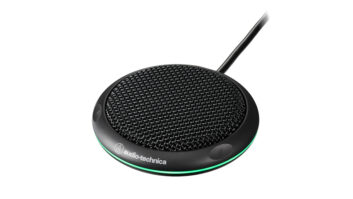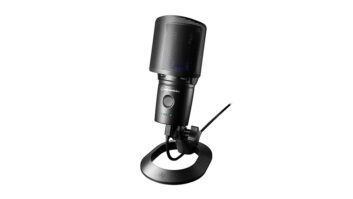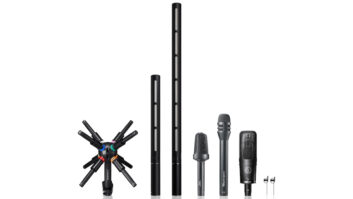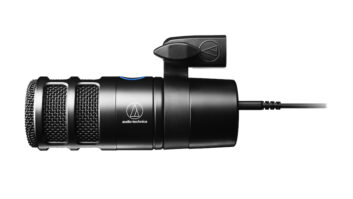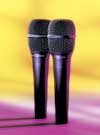
Nine years ago, Audio-Technica began setting its sights on the pro
studio market with the introduction of its AT4031 and AT4051 condenser
microphones. In the years since, these models—which were followed
by the introductions of models such as the AT4033 and AT4050—have
established Audio-Technica as a serious contender in the eyes of
professionals. Over the same time period, A-T also developed
higher-performance handheld mics such as the ATM61HE dynamic and the ATM89R condenser. Audio-Technica has now applied some of
the principles of its 40 Series studio mics to a high-end vocal design
for live performance. The result is the AT4054 and AT4055.
Priced at $499 each, the two microphones are essentially identical,
except the AT4054 incorporates an LF roll-off curve, while the AT4055 has a linear LF
response. To keep the two mics distinctive, the 4054 has a thin blue
line surrounding its windscreen basket.
Physically, the mics are 7 inches long and weigh 10.6 ounces. The
baked-on, non-reflective black finish is tough, and the body fits
nicely into the hand and balances well. The mics are shipped with a
stand adapter but will fit snugly into standard mic clips.
The windscreen is a tough, stainless steel mesh basket that unscrews
easily. Beneath the mesh, an open-cell foam screen provides a second
layer of pop protection and can be removed for cleaning. The mic
capsule, which was derived from the technology used in A-T’s
popular AT4050 studio mic, is housed in a hardened steel enclosure. A
true condenser design, the AT4054/55 uses a medium-diameter,
two-micron-thick, gold-sputtered diaphragm, which goes through a
five-step aging process. According to A-T, the pre-aging process helps
provide consistent performance characteristics over the life of the
mic. From the capsule, the signal is routed through a low-noise,
transformer-balanced preamp, ending in a male XLR (wired pin 2 hot).
After a quick reassembly, I clicked on the console’s 48-volt
phantom power and checked the mics out. Although
the 4055 provides response down to 20 Hz, I was surprised by the
mic’s smooth low frequency response, even on low baritone and
bass voices. The degree of proximity effect was just about
perfect—just enough to provide an extra boost to a performer who
really knows how to “work” a mic, while not being boomy or
mushy. Obviously, with the 4054’s LF roll-off, proximity effect
was substantially reduced, but I liked the fact that the LF attenuation
curve is a gentle -3 dB/octave beginning around 180 Hz, then going into
a -6dB/octave roll-off about 90 Hz, continuing downward. The curve has
a more natural (and far less drastic) sound than the type of LF attenuation typically offered by mics with
roll-off switches. Also, the 4054’s built-in roll-off is
particularly well-suited for use with consoles that lack sweepable HP
filters.
Further up the spectra, the midrange was nicely balanced relative to
the high frequencies. As with most live vocal mics, the 4054/55’s
upper response exhibits a presence boost designed to improve vocal
intelligibility. But in the case of these mics, the HF rise is a long,
gradual slope starting about 1 kHz and ending in +3.5dB peaks centered
around 4.5 and 10 kHz. The net effect is a very natural sound that
worked well for male and female vocalists.
The mic’s polar response is a fairly tight cardioid pattern throughout the midrange. The
tightness of the pattern offers ample rejection of unwanted sounds, and
isolation from sounds coming from 180° (behind the mic) was
excellent. This feature maximizes gain before feedback, though the tightness of the pattern
could be a problem with untrained singers who fail to stay on-axis. The
mics’ off-axis sound was impressive: essentially an attenuated,
uncolored version of the on-axis sound.
In creating the AT4054 and AT4055, Audio-Technica has achieved its
goals of producing live vocal condenser mics that have a natural studio
sound, yet provide excellent feedback rejection. The tight polar pattern may be problematic for some artists,
but professional vocalists who are willing to learn how to work this
mic should be pleasantly surprised at what they hear.
Audio-Technica U.S., www.audio-technica.com

